Juan Luis Cebrián rememora la Transición española en el Cervantes de Londres

El periodista y escritor español Juan Luis Cebrián repasó la Transición española y el papel del diario El País, desde su fundación en 1976, durante su participación en un encuentro de la nueva serie de Diálogos Blanco-White, en una conversación con el director del Instituto Cervantes de Londres, Ignacio Peyró.
Actual presidente de honor de El País, que hoy es el diario de mayor difusión y prestigio en español y que forma parte del grupo de información, educación y entretenimiento PRISA, Cebrián (Madrid, 1944) fue presidente ejecutivo de la compañía matriz hasta enero de 2018.
Peyró, destacó cómo “a todos nos toca ser testigos de la historia, pero solo unas pocas personas tienen la oportunidad de contribuir de modo decidido a modelarla” en referencia a Cebrián, uno de los hombres que considera que “mayor huella” ha dejado en el último siglo de vida pública española, desde que allá en los años 60 cofundara Cuadernos para el Diálogo.

Deslumbrado por Fleet Street
Londres ha sido uno de los lugares de su vida. Primero, como un joven deslumbrado por el ambiente periodístico que se respiraba en las calles alrededor de Fleet Street y la Inglaterra eterna que aún contaba en chelines. Fue aquí donde escribió uno de sus primeros bombazos periodísticos: una entrevista a Manuel Fraga, en la que se le ve con bombín cruzando Hyde Park.
Aquí vivió también Cebrián la entrada del Reino Unido en lo que era entonces el Mercado Común Europeo, ya que se pasó casi un mes haciendo reportajes y entrevistando a mucha gente. Por pura casualidad también pasó aquí la noche de la victoria del referéndum del Brexit, donde, también de casualidad, se encontró con Boris Johnson.

Impresionado por Margaret Thatcher y Fidel Castro
“Uno de los privilegios que he tenido en la vida por dedicarme al periodismo ha sido conocer a muchos Jefes de Estado, algunos muy interesantes como Margaret Thatcher y Fidel Castro, que siempre digo que son los dos políticos más me han impresionado personalmente, diciendo lo mismo en público que decían en privado, cosa muy rara en un político”, exclamó Cebrián.
Con El País se quiso un diario con fuerte vocación intelectual desde el principio, con Rafael Conte, por ejemplo, como crítico literario, y personajes como Jesús Aguirre o Francisco Ayala, que contribuyeron a marcar la temperatura intelectual del periódico. Reconoció que tuvo el privilegio de ser gran amigo de Gabriel García Márquez y de hacer muchos viajes con él; muy amigo de Juan Goytisolo, al que definió como uno de los personajes más desconocidos de la cultura española; y muy amigo de escritores como Carlos Fuentes y Mario Vargas Llosa.
Académico de la Lengua desde 1996 y miembro del Conseil de Surveillance de Le Monde, Cebrián estudió Filosofía en la Universidad Complutense de Madrid, donde se licenció en Ciencias de la Información, tras graduarse en la Escuela Oficial de Periodismo (1963).

Gabriele Finaldi, próximo invitado de los Diálogos Blanco-White
El director de la National Gallery, Gabriele Finaldi, será el próximo invitado de los diálogos Blanco-White el 18 de marzo. Anteriormente a Cebrián, los diálogos en el Instituto Cervantes de Londres contaron con la presencia del chef José Pizarro; el escritor Eduardo Mendoza; y la bailarina y directora del English National Ballet, Tamara Rojo.
Los Diálogos Blanco-White acercan al público británico a grandes personajes relacionados con la cultura española y las relaciones entre Gran Bretaña y España. En un ambiente distendido y relajado, propenso a las confidencias, los invitados mantienen una conversación en profundidad y abierta al público.

British Hispanist and Golden Age Literature Scholar Trevor J. Dadson dies

Hispanist and historian, Trevor John Dadson passed away on January 28th, 2020. A corresponding academic at the Royal Spanish Academy (RAE) with a doctorate from the University of Cambridge, Dadson studied the work of the great poets of Spanish Golden Age: Lupercio Leonardo, Bartolomé Leonardo de Argensola, the Count of Salinas and Gabriel Bocángel.
“Trevor Dadson has been an immensely prestigious Hispanist, a scholar like those who no longer exist; a teacher with a multitude of disciples and a great university manager and promoter of Hispanism and its visibility in the United Kingdom and Ireland. His death is a huge loss because he continued with an impressive intellectual activity. He has been one of the great connoisseurs of our poetry – baroque and contemporary – and frontline characters of our Golden Age,” said the director of the Instituto Cervantes London, Ignacio Peyró.
In addition, Peyró highlighted his study of the Moors in Villarrubia de los Ojos as “a pioneering and model book in cultural studies. His mark is immense, and recently he was lucky to see how many of his disciples gathered articles on Spanish poetry for a tribute book. Dadson was also, and above all, a lover of Spain: its languages, its literature, its culture and its people.”
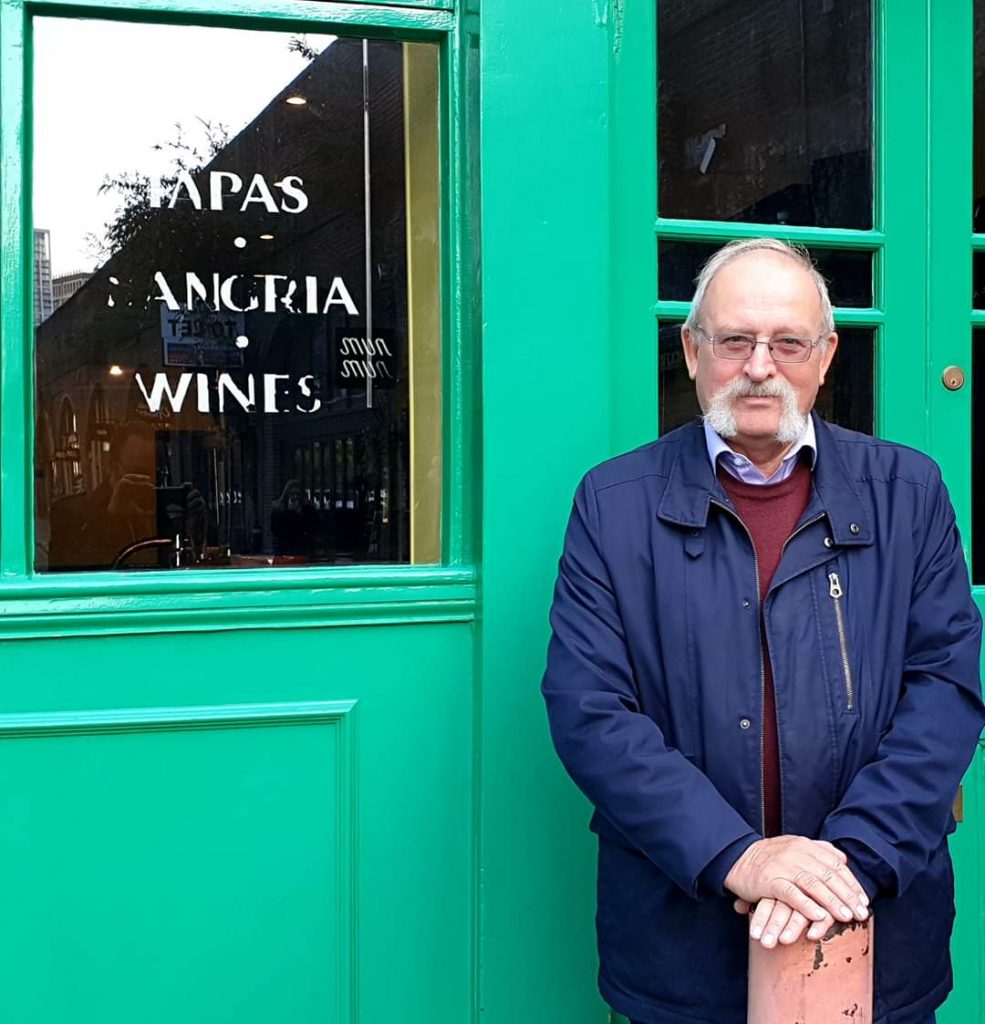
Dadson had a degree in Hispanic Philology from the University of Leeds and a PhD from the University of Cambridge. He was editor in chief of Hispanic Research Journal and Emeritus Professor of Hispanic Studies at Queen Mary College at the University of London.
Born on October 7, 1947, Dadson became part of the British Academy in 2008 and was a professor at the universities of Belfast, UNED and Castilla-La Mancha. In 2015, he was granted the Commendation of the Order of Isabel la Católica by King Felipe VI, for his services to Spanish culture.
That same year, Dadson was interviewed by former director of the Instituto Cervantes in London, Julio Crespo MacLennan, at the headquarters of the Institute in the British capital, as part of the Conversations with Great British Hispanists.
In 2017, Dadson participated in the Tribune of Hispanism, launched by Instituto Cervantes in Madrid, a new forum of meetings in which prominent Hispanism took part, such as the British historian Sir John H. Elliott and the Marquis of Tamarón.
Fallece el hispanista Trevor J. Dadson, gran estudioso del Siglo de Oro

El hispanista e historiador británico Trevor John Dadson falleció la madrugada del 28 de enero de 2020. Académico correspondiente de la RAE y doctorado por la Universidad de Cambridge, Dadson estudió la obra de los grandes poetas del Siglo de Oro: Lupercio Leonardo y Bartolomé Leonardo de Argensola, el Conde de Salinas y Gabriel Bocángel.
«Trevor Dadson ha sido un hispanista de inmenso prestigio, un erudito como los que ya no hay, un maestro con multitud de discípulos y un gran gestor universitario e impulsor del hispanismo y su visibilidad en Reino Unido e Irlanda. Su muerte es una pérdida enorme porque seguía con una actividad intelectual impresionante. Ha sido uno de los grandes conocedores de nuestra poesía -barroca o contemporánea- y de personajes de primera línea de nuestro Siglo de Oro», señaló el director del Instituto Cervantes de Londres, Ignacio Peyró.
Además, Peyró destacó de su estudio sobre los moriscos en Villarrubia de los Ojos como «un libro pionero y modélico en los estudios culturales. Su huella es inmensa, y hace poco tuvo la suerte de ver cómo muchos de sus discípulos reunían artículos sobre poesía española para un libro homenaje. Dadson era también, y ante todo, un enamorado de España, de sus lenguas, su literatura, su cultura y sus gentes».

Dadson era licenciado en Filología Hispánica por la Universidad de Leeds y se doctoró en la Universidad de Cambridge. Fue editor en jefe del Hispanic Research Journal y Catedrático de Estudios Hispánicos en el Queen Mary College de la Universidad de Londres.
Nacido el 7 de octubre de 1947, Dadson formaba parte de la British Academy desde 2008 y fue profesor en las Universidades de Belfast, UNED y Castilla-La Mancha. En 2015 le fue concedida la Encomienda de la Orden de Isabel la Católica por el rey Felipe VI, por sus servicios a la cultura española.
Ese mismo año, Dadson, fue entrevistado por el director del Instituto Cervantes de Londres en aquel entonces, Julio Crespo MacLennan, en la sede del Instituto en la capital británica, dentro del Ciclo de Grandes Hispanistas Británicos.
En 2017 Dadson participó en la Tribuna del Hispanismo, puesta en marcha por el Instituto Cervantes en Madrid, un nuevo foro de encuentros en el que participaron destacados estudiosos de la cultura hispánica, como el historiador británico sir John H. Elliott y el Marqués de Tamarón.
Jose Pizarro: «It is an illusion that people already understand our product»

«All the great Spanish chefs are coming to this country and it is an illusion that people already understand our product, that they understand what is ham, Pimentón, our oils, our vinegars and all the variety of our gastronomic culture,» explained Spanish chef José Pizarro during his participation in a series of talks called the Blanco- White Dialogues, in a conversation with the director of the Cervantes Institute in London, Ignacio Peyró.
Director of Instituto Cervantes in London highlighted how “gastronomy is one of the best tools of cultural diplomacy and that we must support the talent of our creators and entrepreneurs of the great larder that is Spain.»

A very nice and very hard journey
The chef from Extremadura considers himself a very positive person and believes that, in the UK, he is in «a country of diversity and made by us foreigners, although I do not consider myself that way. I consider myself a part of this culture.»
The chef said that what he enjoys the most about London is its «diversity». He remembers falling in love with the British Capital city on his first landing at Gatwick Airport. «It has been a very nice period of my life since I came here; this country from the beginning, it has agreed very well with me, it has given me many opportunities, it has received me very well and opened all the doors.»
Pizarro arrived with only a little English and did not know what he was going to find. Little by little, «fighting, working and enjoying, and with the 100% Iberian ham as a flag,» he made his own space. He defined it as «a very nice and very hard journey too» – full of enjoyment and completely without regret.
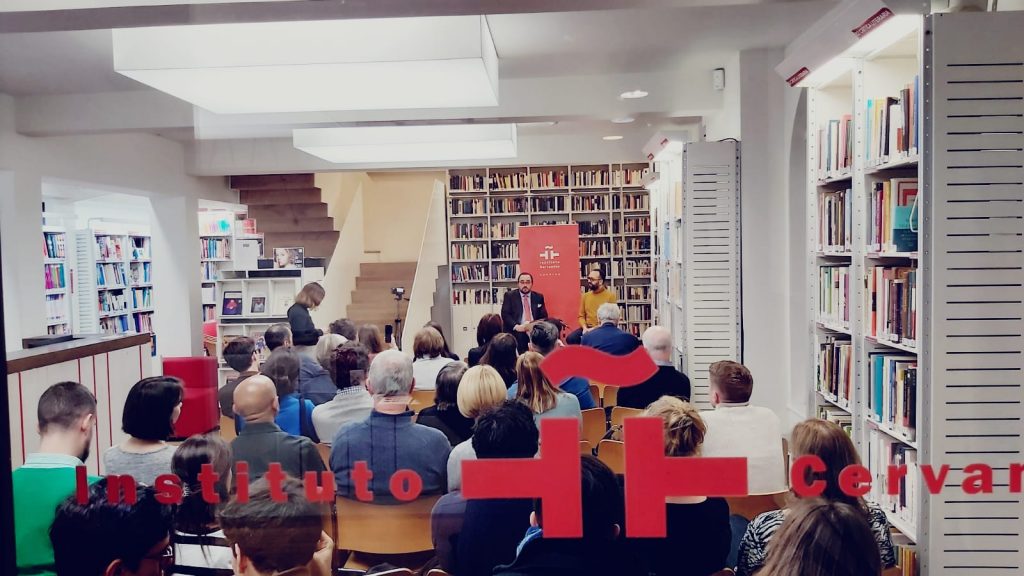
Over his last 20 years in the British capital, Pizarro has tried to rectify the lack of knowledge the UK has about Spanish gastronomic culture. He discovered it was never in the press, and it was not known or talked much about. Many locals confused Spanish products with other countries, for example: Iberian ham was thought to be Italian prosciutto. Pizarro now happily acknowledges that things have «changed a lot», and quoted that now you can find Pimentón de la Vera in any corner of the city.
In the same way, he said that the interest in the Spanish language has risen greatly and the importance of chefs like Arzak and Adriá who both have an impressive projection and creativity.

On his Invitation to the Blanco-White Dialogues
«It is an honor. It is very emotional here, and it’s wonderful for me to be here today at Instituto Cervantes London and to be able to share a little of my life and my journey in my language,» said Pizarro. The Blanco-White Dialogues bring great guests related to Spanish culture and relations between Britain and Spain to the British public.
The next one will be the Spanish journalist and writer Juan Luis Cebrián, in a talk that will take place on Monday, February 3 at 7:00 p.m. Previously, the dancer and director of the English National Ballet, Tamara Rojo, and the writer and Cervantes Prize in 2017 Eduardo Mendoza participated.
José Pizarro: «Es una ilusión que la gente ya entienda nuestro producto»

“Todos los grandes chefs españoles están viniendo a este país y es una ilusión que la gente ya entienda nuestro producto, que entienda lo que es el jamón, el pimentón, nuestros aceites, nuestros vinagres y toda la variedad de nuestra cultura gastronómica”, explicó hoy el chef español José Pizarro durante su participación en un encuentro de la nueva serie de Diálogos Blanco-White, en una conversación con el director del Instituto Cervantes de Londres, Ignacio Peyró.
El director del Instituto Cervantes de Londres destacó como “la cocina es una de las mejores herramientas de la diplomacia cultural y estamos muy contentos de apoyar el talento de nuestros creadores y emprendedores de esa gran dispensa que es España.

Un recorrido muy bonito y muy duro
El chef extremeño se considera una persona muy positiva y cree que está en “un país de diversidad y hecho por nosotros, que somos los extranjeros, aunque yo no me considero así, me considero una parte de esta cultura”.
El extremeño recalcó que lo que más me disfruta de Londres es “la diversidad” y se acuerda de su primer aterrizaje en el aeropuerto de Gatwick, un primer momento desde el que le gustó la capital británica. “Ha sido un recorrido muy bonito desde que llegué a aquí, este país desde el principio, se ha portado muy bien conmigo, me ha dado muchas oportunidades, me ha recibido muy bien y me abierto todas las puertas”.
Pizarro llegó prácticamente sin hablar nada de inglés y no sabía lo que se iba a encontrar, pero poco a poco, “luchando, trabajando y disfrutando, y con el jamón ibérico 100% como bandera”, se ha hecho un hueco. Lo definió como “un recorrido muy bonito y muy duro también”, en el que ha disfrutado mucho y en el que no se arrepiente de nada de lo que ha hecho.

Tras pasar estos últimos 20 años en la capital británica, Pizarro apuntó a como antes no había mucho en prensa sobre la cultura gastronómica española y no se conocía ni se hablaba mucho de ella. Muchos locales confundían el producto español con el de otros países, por ejemplo el jamón ibérico, que se pensaban que era prosciutto italiano, pero el chef reconoce que las cosas “han cambiado mucho”, y sin ir más lejos, citó como ahora se puede encontrar el Pimentón de la Vera en cualquier rincón de la ciudad.
En esa línea, precisó que el interés por el idioma español ha subido muchísimo y la importancia de chefs como Arzak y Adriá, con una proyección y una creatividad impresionantes.

Invitado a los Diálogos Blanco-White
“Es un honor, es muy emotivo y muy bonito para mí estar hoy en el Instituto Cervantes de Londres y poder compartir un poco de mi vida y mi recorrido en mi lengua”, destacó Pizarro. Los Diálogos Blanco-White acercan al público británico a grandes personajes relacionados con la cultura española y las relaciones entre Gran Bretaña y España.
El próximo invitado de los Diálogos Blanco-White será el periodista y escritor español Juan Luis Cebrián, en un encuentro que tendrá lugar el lunes 3 de febrero a las 19:00 horas. Previamente participaron la bailarina y directora del English National Ballet, Tamara Rojo, y el escritor y Premio Cervantes en 2017 Eduardo Mendoza.
The most popular DVDs in our library
A very important part of Instituto Cervantes in London is our library and the movies available to borrow in DVD. We introduce in this post a selection of the most popular ones among our users:
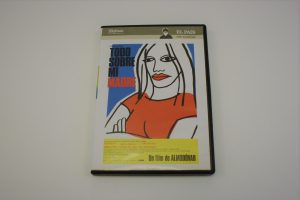
All About My Mother is a film by Pedro Almodóvar. A Greek saying states that only women who have washed their eyes with tears can see clearly. This saying does not hold true for Manuela. The night a car ran over her son Esteban, Manuela cried until her eyes ran completely dry. Far from seeing clearly, the present and the future become mixed up in darkness.
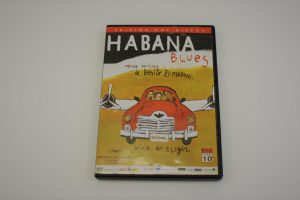
Havana Blues is a 2005 Spanish and Cuban film by Benito Zambrano, which tells the story of two young musicians in Cuba. The film revolves around their music and contains criticism of problems in Cuba such as poverty and electricity outages.
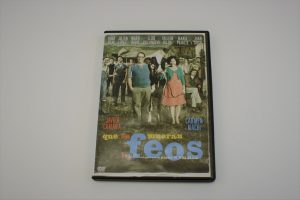
To Hell With The Ugly is a film by Nacho Garcia Velilla. Eliseo (Javier Cámara) is ugly, lame and single. He still hasn’t found the woman of his dreams and he doesn’t really know what love is. Nati (Carmen Machi) is similarly ugly and is currently separated. She’s just met the man of her dreams but she doesn’t know what real love is either. Eliseo, on the other hand, fears that the worst is just around the corner, whilst Nati fantasises that the best is yet to come.
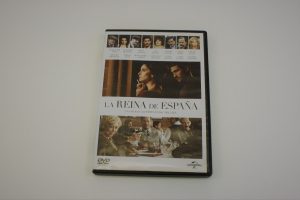
The Queen of Spain is a film by Fernando Trueba. Eighteen years after fleeing Nazi Germany, Spanish film actress Macarena Granada becomes a major Hollywood star. She returns to Spain to play Isabella I of Castille, surrounded by showbiz hype.
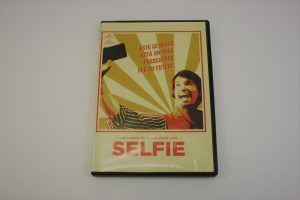
Selfie is a movie by Víctor García León. A privileged young man in Madrid gets a reality check when his father is arrested on corruption charges and all of the family’s assets are seized.
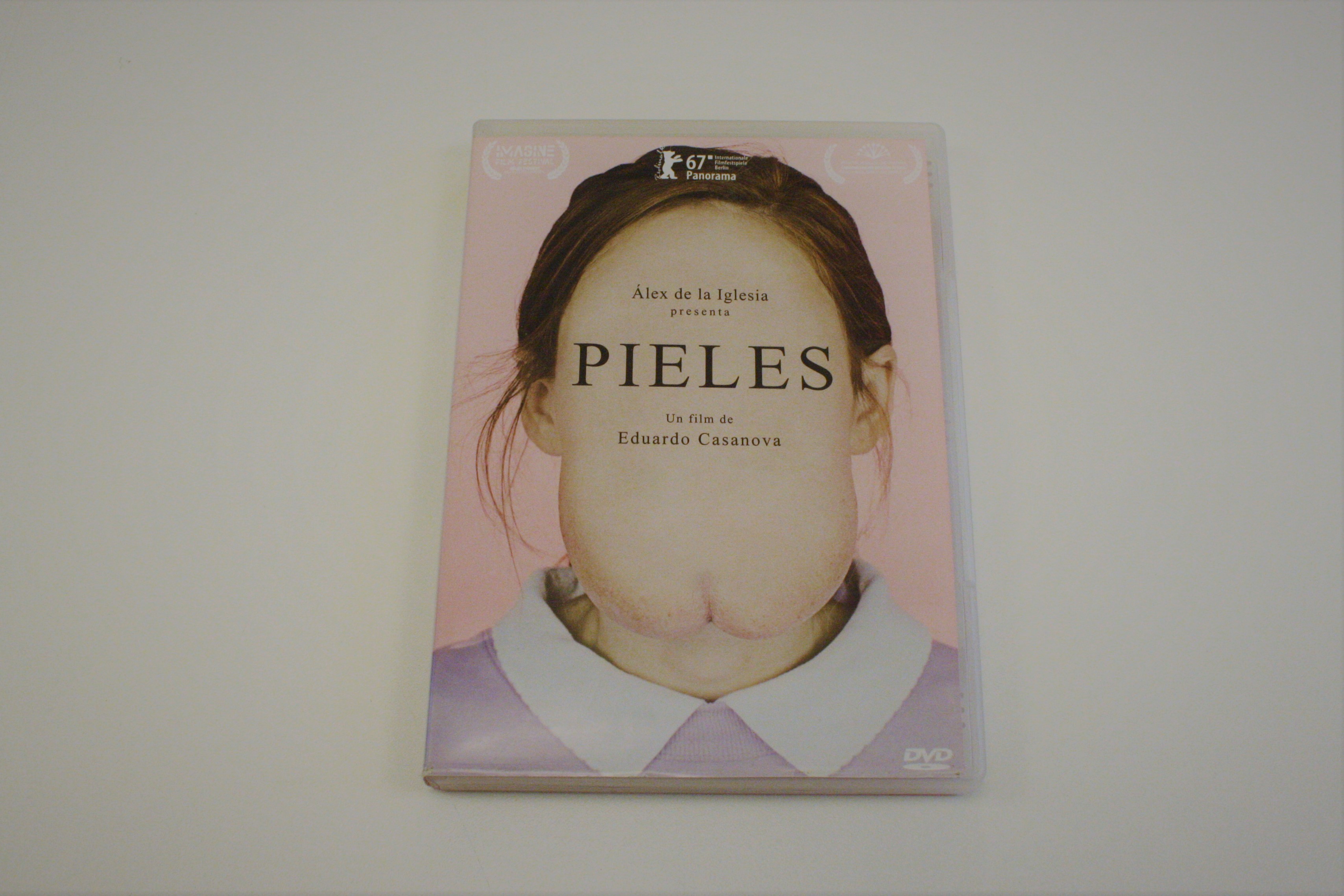
Skins is a film by Eduardo Casanova. Deformed, disfigured characters must find a way to deal with society shunning their differences.
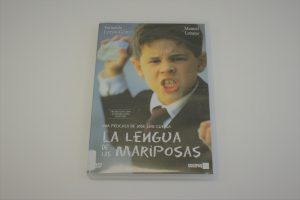
Butterfly’s Tongue is a film by José Luis Cuerda. The heartwarming story of the relationship that develops between a shy young boy and his kind teacher in 1936 Spain. The boy, Moncho, is frightened about starting school, and it is up to the gentle, compassionate Don Gregorio to set the boy’s mind at ease. When the Spanish Civil War erupts, both individuals’ lives are changed forever.
Los DVD más populares de nuestra biblioteca
Una parte muy importante de la biblioteca del Instituto Cervantes en Londres es la sección de películas en DVD. Os presentamos una selección de las más prestadas y las más populares entre nuestros usuarios:

Todo sobre mi madre es una película de Pedro Almodóvar. Un dicho griego dice que solo las mujeres que se han lavado los ojos con lágrimas pueden ver con claridad. Este dicho no es válido para Manuela. La noche que un automóvil atropelló a su hijo Esteban, Manuela lloró hasta que sus ojos se secaron por completo. Lejos de ver claramente, el presente y el futuro se mezclan en la oscuridad.

Habana Blues es una película hispanocubana de 2005 de Benito Zambrano, que cuenta la historia de dos músicos jóvenes en Cuba. La película gira en torno a su música y contiene críticas a los problemas en Cuba, como la pobreza y los cortes de electricidad.

Qué se mueran los feos es una película de Nacho García Velilla. Eliseo (Javier Cámara) es feo, cojo y soltero. Todavía no ha encontrado a la mujer de sus sueños y realmente no sabe qué es el amor. Nati (Carmen Machi) es también fea y actualmente está separada. Acaba de conocer al hombre de sus sueños, pero tampoco sabe qué es el verdadero amor. Eliseo, por otro lado, teme que lo peor esté a la vuelta de la esquina, mientras que Nati fantasea con que lo mejor está por venir.

La Reina de España es una película de Fernando Trueba. Dieciocho años después de huir de la Alemania nazi, la actriz española Macarena Granada se convierte en una gran estrella de Hollywood. y regresa a España para interpretar a Isabel I de Castilla, rodeada de exageraciones publicitarias.

Selfie es una película de Víctor García León. Un joven privilegiado en Madrid recibe una verificación de la realidad cuando su padre es arrestado por cargos de corrupción y todos los bienes de la familia son incautados.

Pieles es una película de Eduardo Casanova. Los personajes deformados y desfigurados deben encontrar una manera de lidiar con la sociedad evitando sus diferencias.

La lengua de las mariposas es una película de José Luis Cuerda. La conmovedora historia de la relación que se desarrolla entre un niño tímido y su amable maestro en la España de 1936 . El niño, Moncho, tiene miedo de comenzar la escuela, y le corresponde al gentil y compasivo Don Gregorio tranquilizarlo. Cuando estalla la Guerra Civil española, las vidas de ambos individuos cambian para siempre
Happy Holidays! – ¡Felices Fiestas!
Our premises will be closed from Friday 20th December 2019, to Sunday 5th January 2020, both included.
The library will be closed from Monday 16 December 2019 to Saturday11 January 2020, both included.
Happy Holidays!
El centro estará cerrado del viernes 20 de diciembre de 2019 al domingo 5 de enero de 2020, ambos inclusive.
La biblioteca estará cerrada al público del lunes 16 de diciembre de 2019 al sábado 11 de enero de 2020, ambos inclusive.
¡Felices Fiestas!
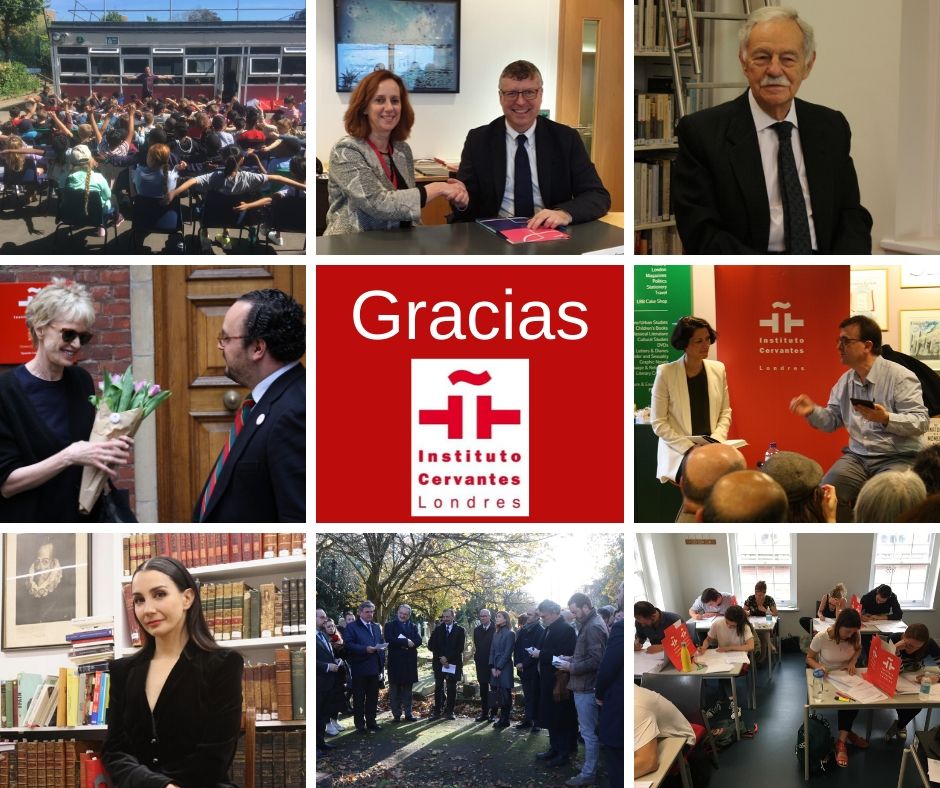
“An enormous opportunity”: enthusiastic response to DADIC, the new Cervantes diploma for Spanish teachers
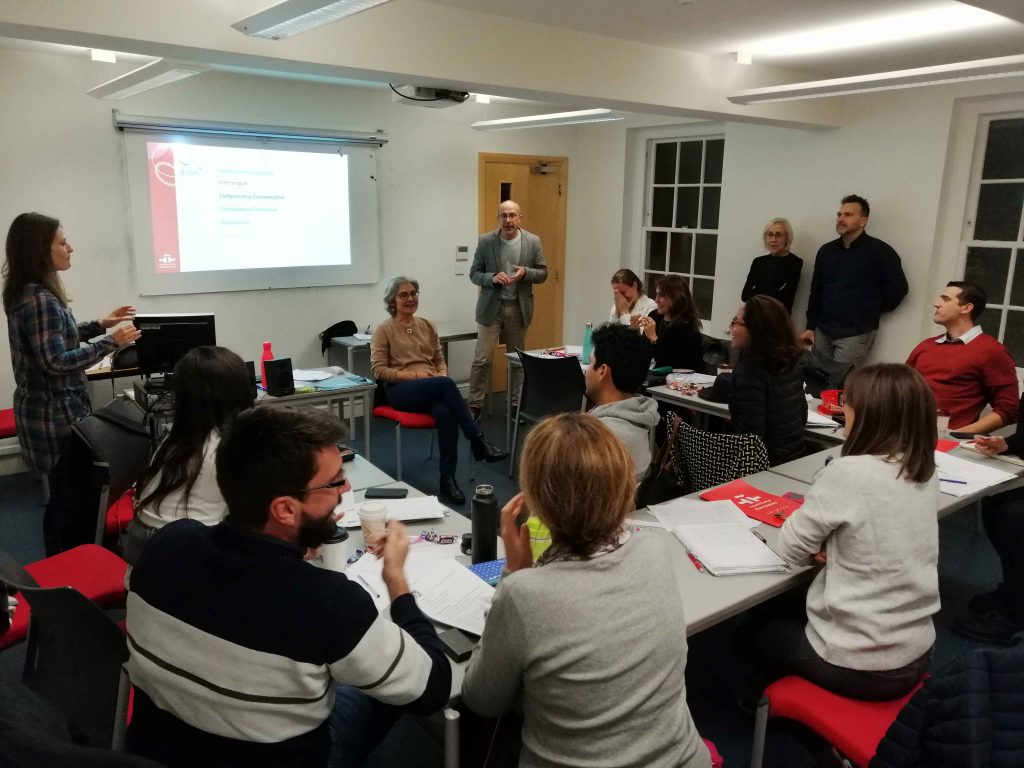
Students who wish to obtain the DADIC (the newly released Diploma of Teaching Accreditation by Instituto Cervantes) to accredit themselves as Spanish teachers in London have defined the initial training as practical and a “tremendously positive and a huge opportunity.»
This training course, aimed at future Spanish teachers, is based on Instituto Cervantes’ own methodology: a student-centred and action-oriented conceptual approach with a strong presence of collaborative and practical work: observation and teaching, development of a portfolio, etc.
Head of Studies, Pablo Martínez Gila explained that the course is based on the teaching practices of students (their experiences as students, the classes they observe and teach at Instituto Cervantes, etc.). Additionally, their analysis and reflections on these experiences helps to build the theory collaboratively. And the result is much more positive than in a traditional teacher training course: students assimilate much better and apply the concepts presented more effectively in class.
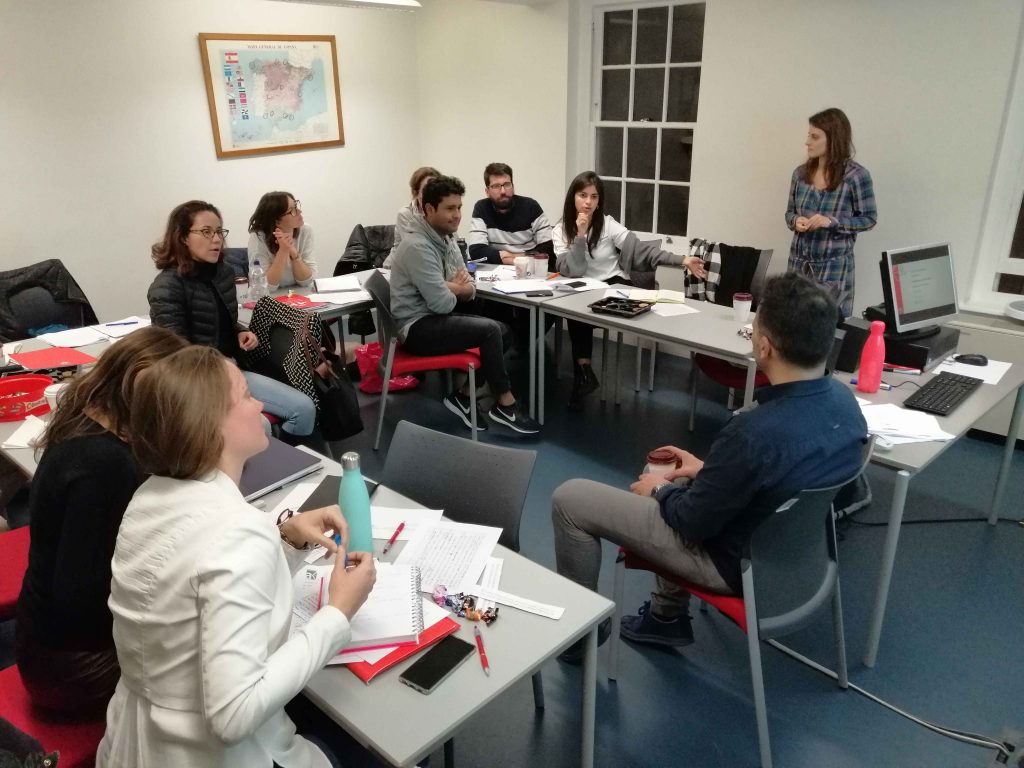
Student Testimonials
Student feedback from the course has wholeheartedly agreed with Martínez Gila that the course is more effective. Julia, a current student of the DADIC, explains: “I had the pleasure of attending two class observations. The experience for me has been amazing and very satisfying. It was the first time I was in a class without being a student. As I was writing everything I saw in class, I realised many things, especially the relationship between teacher and student”.
Equally, another current student, Sandra affirms that the self-evaluations she did in one of the workshops were the most interesting part of the course because they offer a very clear course of improvement: “The grammar and teaching theories can be completed with individual work, but this type of learning in my training can only be done by professionals who guide and support you in such a professional and constructive way”.
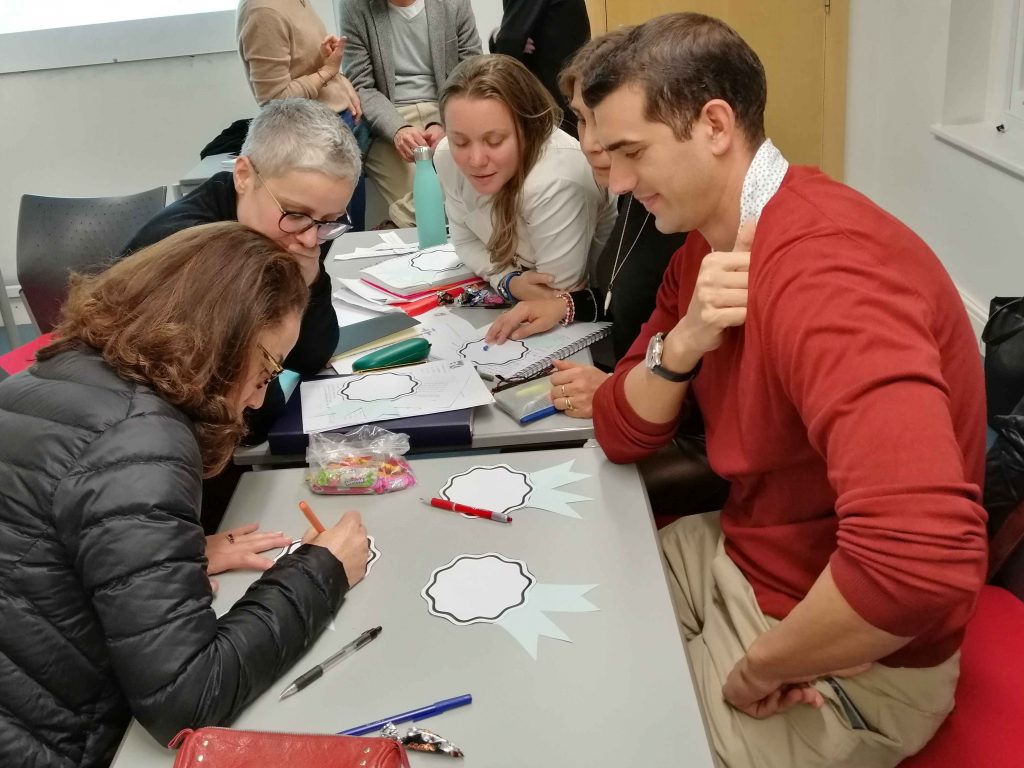
Meeting all expectations
Another student, David, highlights the importance of having addressed the issue of making mistakes and, subsequently, how to identify the best ways of correcting them. The fact that this approach acknowledges that students can make mistakes and learn from them gave David, “a clearer idea about which strategies may be the most useful for correction of oral and written errors.”
“Being honest” – says David – “this course is fulfilling all the expectations I had before enrolling, at this time and concepts unknown to me and I feel confident enough to start this career as a teacher. If I had to highlight some of what I learned, it would be the importance of putting the student at the centre of learning. ”
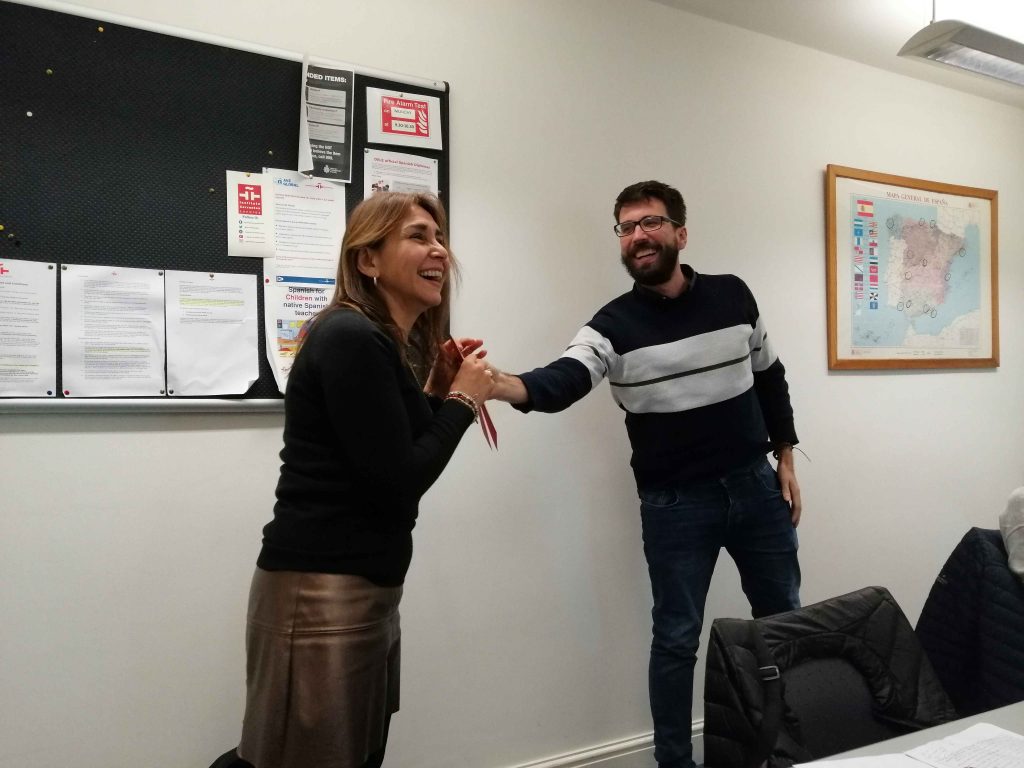
Another student points out that the first part of the course to obtain the Diploma of Teaching Accreditation of the Cervantes Institute (autonomous level) has been a “super positive experience and a huge opportunity to identify and learn from our mistakes. I am very grateful to the teachers for their dedication and I only hope to accumulate hours of experience, enjoyment and to continue learning in the second part. ”
Second part of the course
The second part of the course will take place between January 17 and February 28, 2020, while those interested in starting the first part can enroll for the course that will be taught between May 22 and July 3, 2020
“Una oportunidad enorme”: respuesta entusiasta al DADIC, el nuevo diploma del Cervantes para profesores de español

Los alumnos que desean obtener el DADIC, el recién estrenado Diploma de Acreditación Docente del Instituto Cervantes, para acreditarse como profesores de español en Londres, definen la formación recibida en la primera parte del curso, con un marcado carácter práctico, como “tremendamente positiva y una oportunidad enorme”.
Este curso de formación, dirigido a futuros profesores de español, está basado en la metodología propia del Instituto Cervantes, un enfoque conceptual centrado en el alumno y orientado a la acción, con una fuerte presencia de trabajo colaborativo y práctico: observación e impartición de clases, elaboración de un portafolio, etc.
Según explica el jefe de estudios del centro, Pablo Martínez Gila, en el curso se trata de partir de las prácticas docentes de los estudiantes (sus vivencias como alumnos, las clases que observan e imparten en el Instituto Cervantes, etc.) y de sus análisis y reflexiones sobre estas experiencias para ir construyendo la teoría de manera colaborativa. Y el resultado es mucho más positivo que en los cursos tradicionales de formación de profesores: los estudiantes asimilan mucho mejor y aplican de manera más efectiva en clase los conceptos que se presentan.

Testimonios de estudiantes
Esta percepción de Martínez Gila queda manifiesta en los comentarios de los alumnos a lo largo del curso: “Tuve el placer de asistir a dos observaciones de clases. La experiencia para mí ha sido increíble y muy satisfactoria. Era la primera vez que estuve en una clase sin ser alumna. A medida que iba escribiendo todo lo que veía en la clase, me daba cuenta de muchas cosas, especialmente la relación que hay entre profesor y alumno”, destaca una de las alumnas del curso, Julia.
Sandra, por su parte, afirma que las autoevaluaciones que hizo en uno de los talleres le resultaron la parte más interesante del curso, porque con ellas se cuenta de que es como más puedo aprender y mejorar: “La gramática y teorías de enseñanza las puedo completar con trabajo individual, pero este tipo de aprendizaje en mi formación solo se pueden hacer de la mano de profesionales que te guíen y apoyen de una forma tan profesional y constructiva”.

Cumpliendo todas las expectativas
Otro alumno, David, destaca la importancia de haber tratado el tema del error en los alumnos y cómo identificar cual puede ser la mejor vía para corregirlo, lo cual le aportó “una idea más clara sobre qué estrategias pueden ser las más útiles para la corrección de errores orales y escritos”.
“Siendo sincero –afirma David- este curso está cumpliendo todas las expectativas que tenía antes de matricularme, en este tiempo e interiorizado conceptos desconocidos para mí y me siento con la confianza suficiente para empezar esta carrera como profesor. Si tuviera que destacar algo de lo aprendido sería la importancia de poner al alumno en el centro del aprendizaje”.

Otro alumno puntualiza que la primera parte del curso para la obtención del Diploma de Acreditación Docente del Instituto Cervantes (nivel autónomo) ha sido una experiencia “súper positiva y una oportunidad enorme para identificar y aprender de nuestros errores. Estoy muy agradecido a los profesores por su dedicación y solo espero acumular horas de experiencia, disfrutar y seguir aprendiendo en la segunda parte”.
Segunda parte del curso
La segunda parte del curso se llevará a cabo entre el 17 de enero y el 28 de febrero de 2020, mientras que los interesados en comenzar la primera parte pueden matricularse para el curso que se impartirá entre el 22 de mayo y el 3 de julio de 2020. Para más información, consulte nuestra página web.


